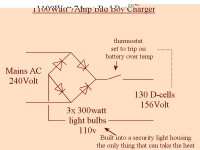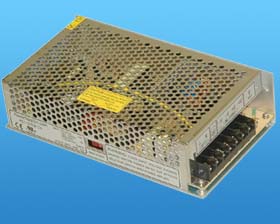Doctorbass
100 GW
"Bad boy charger"
I plan to work on a very light weight emergency charger, to transport with my ebike in case where my pack would go empty faster than i would have expected.
I often heard about a "bad boy charger" that only use few component like a dimmer and a 1:1 transfo with sec and primary serie linked to increase voltage for EV that need more than 169V wich is the peak volt of a 120V RMS outlet. For sure, i know that with this type of charger, the battery pack and the rest of the electrical system of the ebike WOULD NOT BE ISOLATED FROM THE AC LINE and would need special care to avoid electrical shock! :lol:
I just wonder if with few capacitor calculated with 60Hz or a simple light dimer that use a triac combined with a coil and a diode in serie i could finally acheived to a light charger that could give 10-15A at for exemple 84V DC
I dont talk about resistor.. that would dissipate the differential voltage into heat!...
for details see exemple of Bad boy charger: http://www.evalbum.com/tech/
...And of course, it would be used to "add" some Ah to the pakc.. not to fully charge it!... and would need to watch continuously the charging process and the SOC.
any crazy idea?
Doc
I plan to work on a very light weight emergency charger, to transport with my ebike in case where my pack would go empty faster than i would have expected.
I often heard about a "bad boy charger" that only use few component like a dimmer and a 1:1 transfo with sec and primary serie linked to increase voltage for EV that need more than 169V wich is the peak volt of a 120V RMS outlet. For sure, i know that with this type of charger, the battery pack and the rest of the electrical system of the ebike WOULD NOT BE ISOLATED FROM THE AC LINE and would need special care to avoid electrical shock! :lol:
I just wonder if with few capacitor calculated with 60Hz or a simple light dimer that use a triac combined with a coil and a diode in serie i could finally acheived to a light charger that could give 10-15A at for exemple 84V DC
I dont talk about resistor.. that would dissipate the differential voltage into heat!...
for details see exemple of Bad boy charger: http://www.evalbum.com/tech/
...And of course, it would be used to "add" some Ah to the pakc.. not to fully charge it!... and would need to watch continuously the charging process and the SOC.
any crazy idea?
Doc




